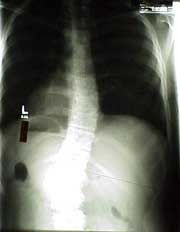Scoliosis
Idiopathic Scoliosis: An anatomically and physiologically based hypothesis of causation
by Dr. Kristofer Young, chiropractor
February 9, 2014 - revision
With any disease or condition, treatment is most effective when causes are understood and treated.
80% of the diagnosed scoliosis in the United States, is termed idiopathic; of unknown origin, unknown cause. Doctors attempt to treat these patients without knowing what is causing the condition.
My advice to all who have interest in idiopathic scoliosis (IS) is that you seek to understand the condition. Don’t give up just because so many others have. Attempting to treat without understanding causation is doomed to less satisfactory, or poor outcome.
My hypothesis is that inflammation in internal organs, symptomatic or not, can, through viscerosomatic reflexes cause chronic, asymmetrical, spinal muscle spasm, and thereby scoliosis.
As a doctor of chiropractic since 1982, I have observed in thousands of patients, that food allergies, food sensitivities, and digestive tract dysfunction often result in tight and tender muscles in the back. Very often the tightness and tenderness are asymmetrical. It dawned on me that if the irritation from these factors were great enough, that scoliosis might result.
In fact, tightness and tenderness in spinal muscles is reduced in individuals with and without IS when irritating foods are removed from the diet, and when digestive dysfunction is resolved.
Every doctor, of every discipline, in the US, has studied anatomy and physiology, and are familiar with nerve pathways called viscerosomatic and somatovisceral reflexes. Viscerosomatic nerves connect each and every organ in the chest, abdomen and pelvis, with the musculoskeletal components of the back. Somatovisceral nerves connect the back to the viscera, the internal organs.
“An example of the somatovisceral reflex (i.e., the musculoskeletal system’s effect on an organ) is the case in which acute low back spasms may cause constipation. In this case, as a result of the back spasm, the muscles of the lower intestine may also go into spasm and create the problem of constipation. Keeping this interactive neurologic model in mind is useful in the process of diagnosis. Thus, if a patient complains of a muscular problem that does not resolve with treatment of muscles, a re-examination may be necessary to see if the muscle dysfunction is related to dysfunction in an organ system. The opposite may also be the case: an organ system may not function properly because of problems in musculature.”
http://www.ncbi.nlm.nih.gov/books/NBK11265/
We can more fully understand viscerosomatic function even without additional academic nor professional science. We can turn to what we all know is true. During a menstrual cycle, with uterine discomfort, many women also experience low back pain. This is not coincidence, the uterus and the low back are interconnected by nerves.
Ulcers can cause back pain. Gall stones can cause back pain. Kidney stones can cause back pain. Bladder infections can cause back pain. And it is not all just about pain. In all of these conditions, an experienced doctor can expect to find tight muscles. Those tight muscles will often be tighter on one side of the spine than the other.
Based on my hypothesis, I recommend treatment of both the musculoskeletal and the visceral components of the condition by a knowledgeable practitioner.
Finally, I request that anyone reading this article, contact me if you are aware of a more compelling hypothesis on the causes of IS.
